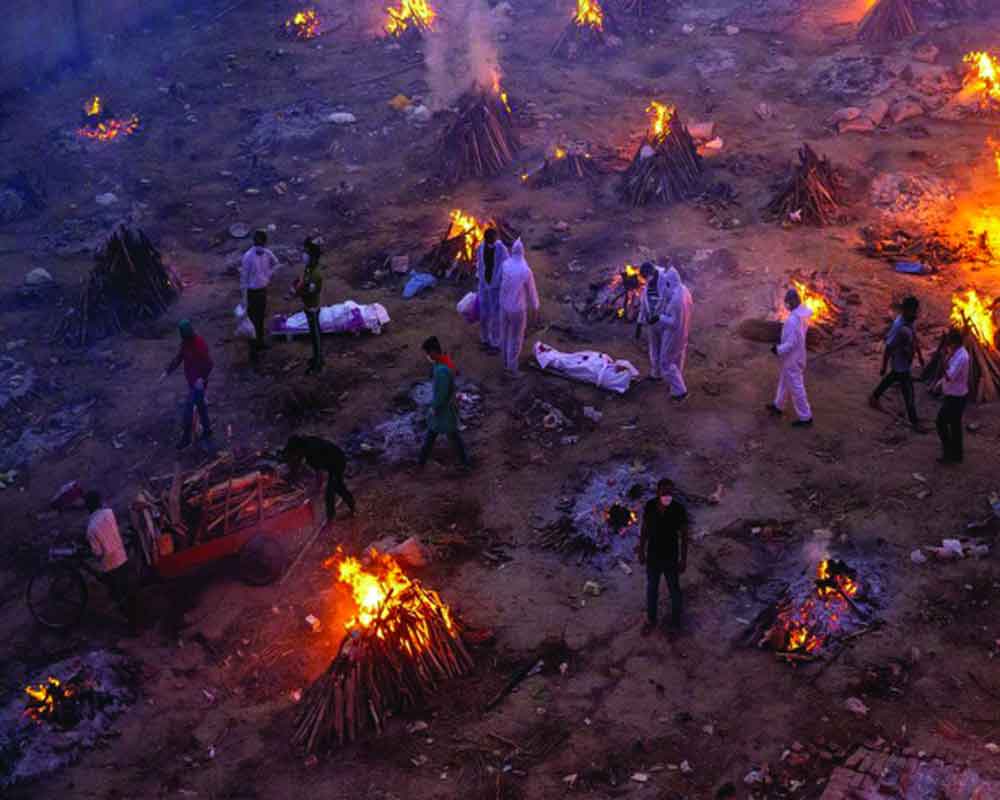The World Health Organisation relied on a modelling methodology to reach its estimates, but the Indian Government has termed it ‘flawed’
A recent World Health Organisation (WHO) report on excess mortality due to COVID-19 pegging the India figure at nearly 10 times the official toll at 47.4 lakh has created a controversy of sorts. On the one hand, WHO’s data suggests that over 90 per cent of deaths in India have gone unreported and its death toll of 5.23 lakh so far is an undercount. The base number of expected deaths (in a non-COVID scenario) for 2020, which the WHO has used in its report, is almost nine lakh more than the average number of deaths recorded each year in India for the last 15 years. The WHO claims that its results are based on well-established mathematical models. Several other studies have shown India’s COVID-related death count at anywhere between 25 lakh to 60 lakh. On the other hand, the report has received a lot of criticism in India.
The Health Ministers of various States who attended a three-day conference of the Central Council of Health and Family Welfare (CCHFW) under the chairmanship of Union Health Minister Mansukh Mandaviya passed a resolution objecting to the WHO’s estimates. They said the report was “intended to show the country in poor light”, and that the modelling methodology used was “flawed”. India has a robust, efficient and comprehensive system for registering deaths and all COVID-19 fatalities are recorded transparently, they said.
For its part, the track record of WHO on COVID has not been above board. Its own study concluded that crucial time was lost in fighting the virus because it delayed the announcement of an international emergency. It spent weeks persuading China to allow a team of international scientists to visit Wuhan after the outbreak. It then swung to the other extreme last year after the relatively less virulent Omicron surfaced, and it rang needless alarm bells instead of educating the world about the new variant.
However, the WHO’s importance can’t be underestimated. For estimating COVID deaths in India, the WHO study has relied, among various sources, on death registration data from the Civil Registration System (CRS). Several media houses had published monthly CRS for a few States last year and these numbers did not always match. Depending on which publication was selected to pick these numbers, the mathematical model would have been different.
According to experts, the WHO report, in case of India or other countries, doesn’t go into the technicality of calculating the scale of the undercount. It has adopted a straightforward method of calculating excess mortality by estimating the total number of people who likely died in India in 2020 due to all causes and has subtracted from that the expected number of all-cause deaths if there was no COVID. These “excess deaths” are considered a result of COVID-19. There is general agreement that because most of the studies have been pointing to similar estimates, they must be reflective of the true toll. But the fact seems to be that the researchers and peer reviewers belong to an overlapping set of people using similar methodology.
Going by deaths per thousand population, India does not figure among the top 100 countries, though the infection fatality rate of 1.2 per cent places it in seventh position, globally. Among the reasons for confusion over accurate COVID death estimates are: One, as accurate death statistics by causes is hard to come by — around 70 per cent of deaths take place at home even normally — attempts have been made to identify “excess” deaths; two, the Supreme Court’s decision to consider all deaths within three months of COVID infliction as COVID deaths resulted in a surge in reporting; three, independent journalists and health statisticians who had sourced registration data and fragmented ground-level information have raised concerns over CRS’ inadequacy. Consequently, the WHO placed India in the category for which COVID death figures are to be generated through modelling and not based on the officially reported numbers.
However, in reality, at this stage, any discussion on the undercount is premature because India has not yet stopped counting its COVID deaths. The figure of 5.24 lakh deaths is under constant revision, and is likely to remain so for some time. Even the death numbers reported in 2020 and 2021 are not final. For example, more than 21,000 deaths Kerala has reported in the last four months have not happened this year. Most of them pertain to last year. Many deaths that would have happened in 2020 but are not included in the 1.49 lakh tally would have been accounted for at later stages. Those deaths have not been missed; these will reflect in the statistics. The same is true for 2021.
The need of an hour is to compile robust data from official sources which should be scientifically collated and validated through field surveys. Unfortunately, reliable data is not available with Government agencies, which is creating miscommunication and confusion leading to speculation. The Government should take appropriate steps to clear the doubts about the actual count of COVID deaths.
(The writer is a senior journalist and Chairman, Panwar Group of Institutions, Solan, Himachal Pradesh. The views expressed are personal.)


























